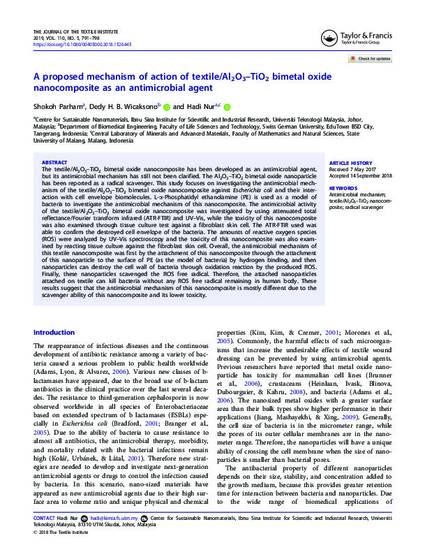
Article
A proposed mechanism of action of textile AI2O3-TiO2 bimetal oxide nanocomposite as an antimicrobial agent
The Journal of The Textile Institute
(2019)
Abstract
The textile/Al2O3–TiO2 bimetal oxide nanocomposite has been developed as an antimicrobial agent, but its antimicrobial mechanism has still not been clarified. The Al2O3–TiO2 bimetal oxide nanoparticle has been reported as a radical scavenger. This study focuses on investigating the antimicrobial mechanism of the textile/Al2O3–TiO2 bimetal oxide nanocomposite against Escherichia coli and their interaction with cell envelope biomolecules. L-a-Phosphatidyl ethanolamine (PE) is used as a model of bacteria to investigate the antimicrobial mechanism of this nanocomposite. The antimicrobial activity of the textile/Al2O3–TiO2 bimetal oxide nanocomposite was investigated by using attenuated total reflectance/Fourier transform infrared (ATR-FTIR) and UV–Vis, while the toxicity of this nanocomposite was also examined through tissue culture test against a fibroblast skin cell. The ATR-FTIR used was able to confirm the destroyed cell envelope of the bacteria. The amounts of reactive oxygen species (ROS) were analyzed by UV–Vis spectroscopy and the toxicity of this nanocomposite was also examined by reacting tissue culture against the fibroblast skin cell. Overall, the antimicrobial mechanism of this textile nanocomposite was first by the attachment of this nanocomposite through the attachment of this nanoparticle to the surface of PE (as the model of bacteria) by hydrogen binding, and then nanoparticles can destroy the cell wall of bacteria through oxidation reaction by the produced ROS. Finally, these nanoparticles scavenged the ROS free radical. Therefore, the attached nanoparticles attached on textile can kill bacteria without any ROS free radical remaining in human body. These results suggest that the antimicrobial mechanism of this nanocomposite is mostly different due to the scavenger ability of this nanocomposite and its lower toxicity.
Keywords
- Antimicrobial mechanism,
- textile/Al2O3–TiO2 nanocomposite,
- radical scavenger
Disciplines
Publication Date
2019
DOI
10.1080/00405000.2018.1526445
Citation Information
Shokoh Parham, Dedy H.B. Wicaksono and Hadi Nur. "A proposed mechanism of action of textile AI2O3-TiO2 bimetal oxide nanocomposite as an antimicrobial agent" The Journal of The Textile Institute Vol. 110 (2019) p. 791 - 798 Available at: http://works.bepress.com/hadi_nur/149/
